|
| Benjy
Steele's
Harley-Davidson Motorcycle
Collection Museum
Follow
the progress of Benjy's Harley-Davidson
motorcycle collection museum.
Click on thumbnails to see how
the project developed from a
condemned warehouse into a beautiful
museum featuring Benjy Steele's
unique collection of antique,
vintage, and modern Harley-Davidson
motorcycles |
|

|
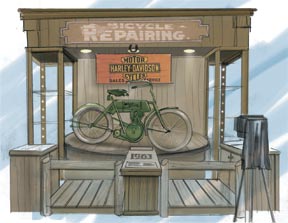
|
| Marker
Renderings
I
was contracted to
do a series of digital
marker renderings
for presentation to
Benjy Steele. I proposed
a time-line theme
that would showcase
the appropriate decade
of each motorcycles
on the stage. Benjy's
enthusiastic response
to the concepts put
the shelved project
back on track to become
reality, and the project
planning begins. |
|

|
| Blueprint
of Stage Layout
Gerry
Cattaneo consulted
with me on the initial
concepts for the Harley
project, brainstorming
the use of curved
stages that border
the room. A blueprint
to scale was developed
to begin ironing out
the size and placement
of stages, and to
study traffic flow.
Benjy Steele required
that the stages must
not protrude into
the room beyond 4
ft., and that the
room be usable for
hosting parties. Production
issues were addressed
and a time table for
manufacturing was
established. |
|

|
| 3
Dimensional Model
I
modeled and rendered
the interior space
of the warehouse,
using architectural
blueprints for dimensions.
At this point, I suggested
the black ceiling,
walls, & floor.
I wanted the fiber
optic lighting to
stand out in the room,
and for the stages
to be the brightest
spots in the room.
I visited Cleveland's
Rock and Roll Hall
of fame to see lighting,
traffic flow, and
to study ideas for
making the motorcycles
viewable, but safe.
The handrail sweep
idea was formed, and
prototypes were started. |
|
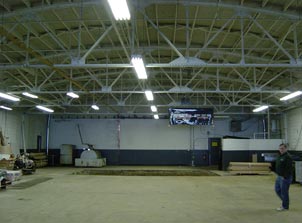
|
Original
Warehouse
The
Active Metal Team
visited the warehouse
to take measurements
and make recommendations
on specs for lighting,
flooring, ceiling
colors, etc. Contractors
were already starting
to remodel the building
structure, and we
had to determine details
of the construction
and fabrication of
the stages. Motorcycles
were studied for size,
weight, and placement
on the stages. A list
of bikes that would
be displayed determined
the placement of each
time-line stage. |
|
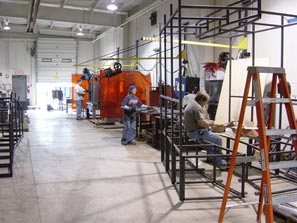
|
Fabrication
and Manufacturing
I
worked closely with
the metal fabricators
as construction began.
The curved-contour
concept had to be
worked out practically.
The wood/metal structures
had to be sturdy,
portable, and had
to contain the fiber
optic system of lighting.
Active Metal had never
attempted to light
such a large area
with fiber optics,
and determinations
about quality of light,
amount of light, distances
the cables had to
travel and where the
illuminator would
sit all had to be
configured. Jim Kline,
President of ProModel
was experimenting
with how to make the
lighting illuminate
the motorcycles. |
|

|
3Dimensional
Rendering of Stages
I worked on design
concepts for each
stage, and modeled
them in Maya 3D. The
client could approve
the themes as the
construction of the
stages began. Each
decade of Harley-Davidson
history was represented
by multiple motorcycles,
so placement of the
restored bikes was
critical. I was determining
how stage design would
coordinate with specific
bikes. Many determinations
were made from the
3D models, including
height of the stages,
how the protective
rails would work,
and the design and
placement of graphics. |
|
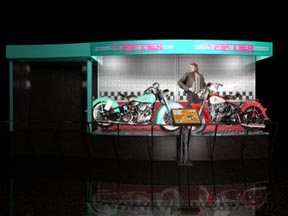
|
3Dimensional
Rendering of Stages
The design concept
of each decade had
to be approved in
the 3D model stage,
so that production
could begin on the
decorative "skin"
of each of the stages.
The diner-car styled
3D model showed checkered
tiles, chrome, and
neon-light lettering
for the top banner.
I researched materials
that could be used
to match the look
of the approved 3D
model rendering |
|

|
3Dimensional
Rendering of Stages
Benjy
Steele had various
memorabilia that he
wanted displayed with
each corresponding
decade, and with the
appropriate motorcycles
on that stage. Posters,
clothing, antique
mannequins, engines,
and Fine Art had to
be coordinated. I
was photographed and
composited each motorcycle
into the Maya 3D rendering
for a complete look.
|
|
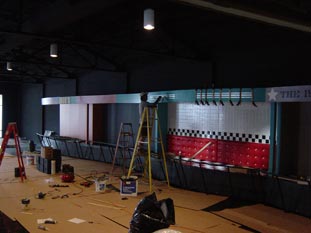
|
Installation
Begins
The
various elements of
the final stages were
shipped to the site
so that installation
could begin. What
had only existed as
a virtual model had
to fit together properly
in reality in order
for the total concept
to work. |
|

|
3D
Model of Informational
Kiosk
I
developed the concept
of a back-lighted
kiosk to provide informative
history in front of
each motorcycle stage.
Active Metal wanted
the stands to compliment
the feel of the themed
interior. I modeled
how the light box
would set on supports,
how high it should
be, how it would be
supported by the rail,
(but removable). This
helped the manufacturing
team build the unit
to fit the stages. |
|

|
Photo
of the 1930's Stage
I
airbrushed the header
and backdrop of the
final 1930's stage,
using an old photo
of Rt 66 for reference.
The painted road extends
forward onto the base
of the stage under
the motorcycles. Tank
designs featured on
the original 1930's
era Harley displayed
on this stage inspired
the stage header graphics.
I used Bulletin sign
painters colors on
sign painters aluminum-core
panels. |
|

|
Photo
of the 1940's Stage
I
chose a muted palette
of warm gray for the
backdrop of the World
War II-era stage.
Benjy's two war-time
motorcycles are displayed
on the corner stages
next to this 1940's
stage, and post-war
Harley's are positioned
in front of limited
edition prints that
depict these same
bikes. |
|

|
Photo
of the 1950's Stage
I
selected checkered
tiles, red vinyl seating
materials, and flooring
for the diner-car
inspired Fifties stage.
The look was enhanced
by Neon lights and
chrome on the header.
I had the stage painted
in turquoise to compliment
the colors of the
1950's motorcycles
on display.
|
|

|
Photo
of the 1960's Stage
I
used the colors and
look of the flower-power
sixties for stage
representing the turbulent
60's era. Benjy propped
it with actual memorabilia
from the Easy Rider
movie, including a
leather jacket and
signed movie posters.
|
|

|
3Dimensional
Portable Stage
Benjy
requested a portable
stage that would display
a motorcycle and artwork.
He needed to be able
to disassemble and
relocate the stage
inside his dealership
in an neighboring
building. He wanted
the fiber optic lighting
included as a feature
on the stage. Lighting,
cables, and a demonstration
of stage assembly
are shown in this
3D model. |
|
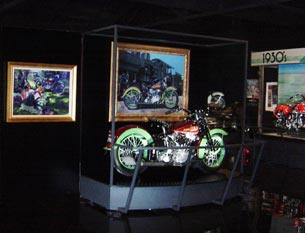
|
Final
Portable Stage
Benjy's
lovingly restored
1930's era antique
Harley-Davidson is
displayed on a portable
stage, backed with
an original oil painting
of the same motorcycle. |
|
|

|

|

|
|
Marker
Sketch |
Blueprint
of Stage Layout |
3Dimensional
Model
|
|
|
|
|
|
Original
Warehouse |
Fabrication |
3D
Model of 1930's Stage |
| |
|
|
| 3D
Model of 1950's Stage
|
3D
Model of 1960's Stage |
Installation |
| |
|
|
| 3D
Model of Information
Kiosk |
Information
Kiosk |
Photo
of 1930's Stage
|
| |
|
|
| Photo
of 1940's Stage
|
Photo
of 1950's Stage
|
Photo
of 1960's Stage
|
| |
|
|
| 3D
Model of Portable
Stage |
Photo
of Final Portable
Stage |
|
|